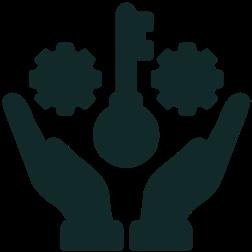FED COMMUNITY WORKBOOK
FOR PRODUCE PRESCRIPTION PROGRAMS



Summer 2023
Edition 1
This Community Workbook is intended to support a group of partners in the design or iteration of a Produce Prescription Program using the FED Principle® (Fidelity, Equity, and Dignity)
Table of Contents
List of Figures and Tables Figure 1: The FED Principle®: Fidelity, Equity, and Dignity 08 Figure 2: Groundwater Framing 09 Table 1: Comparison of Non-FED PRx Program and FED PRx Program 11 Acknowledgements 04 How to Use this FED Community Workbook 05 The Fidelity, Equity, and Dignity (FED) Principle® 08 What Does a FED-Aligned Program Look Like? 11 FED Program Criteria 12 FED Program Touchpoints 13 • Participant Recruitment & Eligibility Screening 14 • Prescription Provided 15 • Prescription Redemption 16 • Nutrition/Culinary Education 18 • Data Collection and Evaluation 20 • Program Management 22 • Program Funding & Sustainability 24 FED Program Assessment Worksheet 26 The FED Journey: A Work in Progress 30 Appendix 1: Lead Contributor Biographies 31
2 // FED Community Workbook 2023
Wholesome Wave
is a national non-profit established on the belief that everyone, regardless of race, age, ethnicity, or income has a fundamental right to choose healthy food. Wholesome Wave’s mission is to address disparities in diet-related disease and enhance nutrition equity by making fruits and vegetables more accessible and affordable to low-income community members through systems change. Founded in 2007 by James Beard Award-winning Chef Michel Nischan and former USDA Undersecretary of Agriculture Gus Schumacher, Wholesome Wave successfully established the legal framework and advocated to fund the doubling of SNAP benefits when spent on healthy fruits and vegetables—a program that has reached millions of community members across the country and has been established as a permanent program in the 2018 Farm Bill, named the Gus Schumacher Nutrition Incentive Program. Today, Wholesome Wave is leveraging our 15 years of experience and relationships supporting successful fruit and vegetable access programs to advocate for their inclusion as a covered healthcare treatment through government-sponsored health plans. Visit us at wholesomewave.org.

Wholesome Wave Leadership
Michel Nischan, Co-Founder and Chairman
Natalia Feinstein, Executive Director
Benjamin Perkins, FED Director, Board of Directors Member, FED Committee Chair
Brent Ling, Director of External Affairs
Stacy Hicks Herr, Director of Strategic Partnerships & Engagement
DAISA Enterprises
is a national consulting firm working at the intersection of food, culture, and health. We partner with social enterprises, nonprofits, policy makers, and investors to drive equitable food systems change and support the development of vibrant communities. DAISA provides innovative strategic and operational services including national field scan research, large-scale funding initiative design & management, and convening planning & facilitation. The DAISA team also facilitates the national Equitable Food Oriented Development (EFOD) Collaborative and serves as a Technical Assistance provider for multiple Communities of Practice for produce prescription practitioners. Visit us at daisaenterprises.com.
DAISA Enterprises Leadership

S. Maham Rizvi, Food Systems Manager, Produce Prescription Specialist
Maria Elena Rodriguez, Director of Research & Community Partnerships
Daniel Ross, Partner & CEO
Foundational Research: Produce Prescription Programs US Field Scan Report: 2010-2020. Published by Wholesome Wave April 2021. Available at: wholesomewave.org/news/field-scan
Funding for the development of this Community Workbook provided by the Walmart Foundation through the Walmart.org Center for Racial Equity.
Design and layout by Substantial Media LLC 3 // FED Community Workbook 2023
Acknowledgements
The FED Criteria were developed with the guidance of a National Advisory Group (NAG) comprised of produce prescription practitioners, health equity leaders, racial justice thought partners, healthcare funders, policy advocates, and evaluation experts. The NAG reviewed and discussed all materials, submitting changes to better align the criteria and principles with the complex reality of the field. We thank this group for their immensely valuable leadership and contributions.
• Lawrence Vinson, American Heart Association
• Dr. Marlene Schwartz, UConn Rudd Center for Food Policy & Health
• Rafael Perez-Escamilla, Yale School of Public Health
• Christian Douglass, Racial Equity Institute
• Marsha-Gail Davis, American College of Lifestyle Medicine
• FJ Perfas, Massachusetts Department of Public Health
• Kaely Summers, Oregon Health & Science University
• Henry Crews, Green Rural Redevelopment Organization
• Dr. Kirti Malhorta, UC Davis/Sacramento County Health
• Khoban Kochai, UC Davis/Sacramento County Health
• Stacey Barbas, Kresge Foundation

This Community Workbook was created with additional support from:
• Elizabeth C. Rhodes, Emory University, Rollins School of Public Health
• Kathleen O'Connor Duffany, Yale School of Public Health
• Christa Drew, former DAISA Principal
• Alexis Babaian, former DAISA Associate
• Sandy Steigbigel, former Wholesome Wave Program Director
• Trisha Chakrabarti, Director, Equitable Food Oriented Development (EFOD), DAISA Enterprises
• Bayard Love, Racial Equity Institute
4 // FED Community Workbook 2023
How to Use this FED Community Workbook
The FED Principle® is a new model that centers the core values of Fidelity, Equity, and Dignity (FED) in food systems and prioritizes community-led program design. Page 8 has a full explanation of the FED Principle®. This workbook provides guidance for a program development or improvement process for produce prescription (PRx) programs interested in better aligning their work with these core values of social justice.
Who Should Use This Workbook?
While many healthy food access initiatives may find this model applicable, it was developed specifically with PRx programs in mind. The National Produce Prescription Collaborative defines these programs as:

A Produce Prescription (PRx) Program is a medical treatment or preventative service for patients who are eligible due to diet-related health risk or condition, food insecurity or other documented challenges in access to nutritious foods, and are referred by a healthcare provider or health insurance plan. These prescriptions are fulfilled through food retail and enable patients to access healthy produce with no added fats, sugars, or salt, at low or no cost to the patient. When appropriately dosed, PRx Programs are designed to improve healthcare outcomes, optimize medical spending, and increase patient engagement and satisfaction (NPPC, 2021).
PRx programs are typically multifaceted and require a diverse set of partners or collaborators working together to bridge food and healthcare systems. Each interaction of these program partners creates a program touchpoint - a major function or process in program implementation. Each of these touchpoints provides an opportunity to consider how programs can further embed values of equity and inclusion into program operations and partnership development. Common program touchpoints - and those explored in this Workbook - include:
• Participant Recruitment & Eligibility Screening
• Prescription Provided
• Prescription Redemption
• Nutrition / Culinary Education
• Data Collection and Evaluation
• Program Management
• Program Funding & Sustainability

5 // FED Community Workbook 2023
1 https://www.nppc.health/
This Community Workbook is designed as a tool for Program Operators to assess their program touchpoints in collaboration with the involved partners. Depending on the particular program composition, the above touchpoints will likely involve the participation of a wide range of partners including healthcare providers, community-based organizations, program participants / patients, community health workers or promotores de salud, public health departments, food retailers, farmers’ markets, nutrition educators, evaluators, researchers, funders, payers, and technology providers. The lead entity that holds the role of “program operator” may vary, depending on where management of the program originates.
How Can This Workbook Be Used?

To begin this exploration, the next section provides a definition of the three core values of the FED Principle® and additional context for their development. On page 11 we provide a comparison table to help distinguish the differences between a FED-aligned PRx program and a non-FED-aligned program. Beginning on page 12, we provide a detailed set of FED Criteria for programs to consider, organized by each of the above-mentioned PRx program touchpoints. These Criteria illustrate some of the many possibilities that exist to better align program operations with the FED Principle®. Following the FED Criteria is a Program Assessment Worksheet.
We encourage program partners to use the Criteria and Worksheet as a guide to explore how to further build systemic equity into your PRx initiative. The FED Principle® is based in community-led design - centering the participation and lived experiences of patients, program participants, and community members is fundamental to this process. We recommend that you complete this assessment process at least once per year to document your progress along this journey.
While great care and intention have gone into the development of these Criteria, we believe that they will become stronger through further testing and diverse perspectives. These Criteria are intended for discussion and iteration directly by community members, practitioners, and patient-participants, and we look forward to improving them based on community feedback. We recognize that many PRx and food access programs have already taken steps to align their program models with equity principles. This workbook synthesizes existing examples of equity embedded in PRx program operations, and shares a framework for conversations that can push this work in new or different directions.

6 // FED Community Workbook 2023
2 https://www.cdc.gov/minorityhealth/promotores/index.html
Our goal is that the FED Principle® provides the PRx field with a common language to define and articulate these shared equity values in practice.


7 // FED Community Workbook 2023
The Fidelity, Equity, and Dignity (FED) Principle®
The FED Principle® was designed to provide clear and rigorous guidelines through which PRx programs can better embed racial justice values into their program operations and partnership development. It refers to 3 core values:


Fidelity
The belief and commitment that meeting communities where they are, means building solutions that serve them.

Programs should serve communities and not the other way around.
Equity
We work tirelessly to ensure that our efforts increase access to nutritional foods for our most vulnerable community members, and we should always interrogate our policies and practices to ensure that we are achieving that goal.
Dignity
Human beings have inherent worth regardless of their station in life, which is why we are all deserving of health and wellbeing. Nutritious food is the vehicle by which we affirm and celebrate human dignity.

8 // FED Community Workbook 2023
Groundwater Framing
Structural racism is the root cause of disparities, it is not the fish that are failing but the groundwater has been affected.

Groundwater solutions are needed to address systemic issues.
Created by Bayard Love and Deena Hayes-Greene of the Racial Equity Institute, the Groundwater Approach distinguishes public health and social benefit initiatives that focus on individual outcomes (the “fish”) from those that understand that that the systems (the “Groundwater”) around people are what produce broad disparities.
Our groundwater metaphor is designed to help practitioners at all levels internalize the reality that we live in a racially structured society, and that that is what causes racial inequity. The metaphor is based on three observations: racial inequity looks the same across systems, socioeconomic difference does not explain the racial inequity; and inequities are caused by systems, regardless of people’s culture or behavior.”
-Bayard Love and Deena Hayes-Greene, Racial Equity Institute
Food insecurity and diet-related chronic disease are also clearly “groundwater” problems, by their prevalence we can see that they are not the impact of individual choices. Decades of public health data point to the importance of healthy food options in overall health and wellbeing but the U.S. Department of Agriculture estimates that 54.4 million Americans live in low-income areas without sufficient access to healthy food. This lack of access is deeply rooted in racist redlining practices, disinvestment in communities of color limiting development of food retail, displacement of Indigenous land stewards and Black farmers, policies preventing food production in low-income neighborhoods, pervasive poverty, and other inequitable structures that have prevented generational wealth-building and buying power.
4 https://ageconsearch.umn.edu/record/262134

9 // FED Community Workbook 2023
Artwork by Jojo Karlin (jojokarlin.com)
Figure 2: Groundwater Framing, Bayard Love and Deena Hayes-Greene of the Racial Equity Institute
Additionally, since 2014, diet-related diseases including type-2 diabetes, heart disease, hypertension, and stroke have surpassed smoking as the number one cause of death in the United States. Black, Indigenous, and Latinx communities bear a disproportionate impact in the form of increased rates of type 2 diabetes and hypertension. Meanwhile, 80% of healthcare system costs - representing over $1 trillion - are diet-related5. We know that these endemic and pervasive health issues exist in the US due to systemic racism and structural barriers.

Love and Hayes-Green urge practitioners to adopt this Groundwater metaphor and develop approaches that incorporate a full understanding of these systemic failures:
“Embracing these truths forces leaders to confront the reality that all our systems, institutions, and outcomes emanate from the racial hierarchy on which the United States was built. In other words, we have a ‘groundwater’ problem, and we need ‘groundwater’ solutions.”
-Bayard Love and Deena Hayes-Greene, Racial Equity Institute

Traditional healthcare programming can too often focus only on the “fish,” concentrating primarily on individual patient choices and outcomes. The FED Principle® for PRx programming and other food access initiatives recognizes that programming must also take into account the “groundwater” determinants of systemic disparities in order to have true success. It helps program partners implement strategies to improve the “groundwater” of systems and environment, not necessarily with larger budgets or more complexity, but with community agency and thoughtful choices. The FED Principle® provides PRx programs with tangible criteria to assess and improve program delivery to further the transformational potential of PRx and food access programs, for true long-term community health and well-being.
To fully understand the Groundwater context of PRx programming, Wholesome Wave and DAISA Enterprises worked directly with community-based field leaders who are addressing health and structural racism in their communities. The development of the FED Principle® and Community Workbook happened in parallel with new collaborative research conducted in 2021-2022 to better understand the experiences of Black, Indigenous, and other People of Color (BIPOC) produce prescription operators in the field. The research findings discuss in rich detail both the ways in which BIPOC leadership enhances and strengthens food as medicine initiatives and also the complex challenges to their program success. It also provides a set of actionable recommendations for various field stakeholders including philanthropy, peer organizations, networks and technical assistance providers, and policy advocates. As of early 2023, this research is being submitted for publication as a peer-reviewed journal article with anticipated publication in late 2023.
5 https://www.rockefellerfoundation.org/report/reset-the-table-meeting-the-moment-to-transform-the-u-s-food-system/
10 //
What Does a FED-Aligned Program Look Like?
A conventional produce prescription program and a FED-aligned program share some basic functions and understandings, including:
• Measurable health changes
• Coordinated network of healthcare, community, and retail partners
• Basic formation of healthcare partners issuing prescriptions for healthy food
However, there are significant underlying differences in approach, as outlined below:
Focuses primarily on individual patient health and pathologies such as obesity and chronic disease. Outcomes are focused on changes in patient biometrics.
Places importance on family, household, and community health. Measured outcomes include social cohesion, mental health, and evidence of power shifting.
Assumes patients have deficits of knowledge and decision-making
Focuses only on changing patient diet, and patients' personal choices
Extracts data for reporting, focus on biometrics
No attention to where prescription dollars go after produce transaction, only convenience and efficiency considered
Patients have a right to nutrition
Dietary guidance and healthy food access framed primarily by white dominant food culture norms
Patients have assets of wisdom, culture, and community
Focuses on full human, social change for equity in access and community partnerships, holistic and peer support, thinks systemically
Learns together for long-term community health, holistic human and community change data; examines racial health disparities/inequities
Prescription redemption drives development of a stronger food system and environment, with attention paid to local farmers and BIPOC/community-owned food nfrastructure and asset building
Communities also have rights to Fidelity, Equity, and Dignity
Guidance and access inclusive of cultural practices, food quality and variety, and agency of participants E
While this table may show these differences in a binary way (Non-FED vs. FED) to clearly illustrate the differences, in fact for each of the above criteria there is a spectrum of approaches. Likely there are many other dimensions that can contribute to Fidelity, Equity, and Dignity as well as the above comparisons. However this breakdown shows some of the clear differences in core principles that do matter in implementation, decision-making, and understanding of the community context.
 Non-FED PRx Program
FED PRx Program
Non-FED PRx Program
FED PRx Program
FED Category
F = Fidelity
E = Equity
D = Dignity
F Top-down, external health intervention
and participatory processes F
Community-driven
D
E
F
E
E
11 //
Table 1: Comparison of Non-FED PRx Program and FED PRx Program
FED Program Criteria





The below Criteria are organized by potential program touchpoints noted in the first section of this Workbook. Each set of Criteria are designated as corresponding most closely to one of the three core values of the FED Principle® - Fidelity, Equity, and Dignity. To aid in navigating and contextualizing the Criteria, we have then categorized each according to the following themes.




ACCESSIBILITY COMMUNITY TRUST ENGAGEMENT FOOD SOURCING LABOR LANGUAGE OWNERSHIP PARTICIPANTCENTRIC PRIVACY TRANSPARENCY TRAUMAINFORMED
12 // FED Community Workbook 2023
There is no expectation that any single program would apply these criteria in the same way, or adhere to every single one of the criteria in this workbook; fidelity, equity, and dignity can look different in varying community circumstances. The criteria outlined here are aspirational and invitational and they aim to help program operators and partners to have the conversations necessary to further embed these values.
FED Program Touchpoints
• PARTICIPANT RECRUITMENT & ELIGIBILITY SCREENING
• PRESCRIPTION PROVIDED
• PRESCRIPTION REDEMPTION
• NUTRITION / CULINARY EDUCATION
• DATA COLLECTION AND EVALUATION
• PROGRAM MANAGEMENT
• PROGRAM FUNDING & SUSTAINABILITY

Workbook Activity Prompts
Prompt #1: What criteria do you already implement? Put an ”*” on the line next to each criteria your program already implements.
Prompt #2 What criteria doesn't work for you? Put an “X” on the line next to each criteria you find irrelevant, not feasible, or even potentially harmful for your program’s circumstances.
Prompt #3: What criteria are you less familiar with, but want to try? Put an “ ! ” on the line next to any criteria you have not implemented, but feel drawn to or excited about.
13 // FED Community Workbook 2023
Participant Recruitment & Eligibility Screening

In order for potential program participants to gain access to the program, an outreach, recruitment, and eligibility screening process must take place. Depending on the design of the specific program, these steps may be conducted by the same entity, or they may be shared amongst partners. In many produce prescription programs, the healthcare partner completes the eligibility screening process as a part of a routine medical appointment with a patient. Healthcare partners may conduct recruitment through their health and wellness programs or EMR screening, or a community-based organization may do direct outreach and engage local community members to make them aware of the program. Please use the workbook activity prompts on page 13. Place a [ * ] | [ X ] | [ ! ] in the line next to each criteria.

FIDELITY

1. PARTICIPANT-CENTRIC / COMMUNITY TRUST – Outreach strategies should be informed by communities, rather than solely identified by statistical information on demographics and access. This level of initial community work will improve enrollment, participation, and participant experience. Through community charrettes or discussions a program can better identify program aspects such as potential underserved target populations, where community members go for healthcare services and where they shop, in addition to expanding the outreach and recruitment pool.
2. PARTICIPANT-CENTRIC – Customizable questionnaires based on community design, needs, or interests. While standardization is helpful for scaling technology solutions and health interventions, creating opportunities for communities to define their own health goals and metrics is crucial for fostering community fidelity, ownership, and agency.
EQUITY

1. LANGUAGE – Staff speak languages of community members being recruited – being able to reach people through shared language is critical in informing potential enrollees and building trust and understanding.
DIGNITY
1. PARTICIPANT-CENTRIC / TRAUMA-INFORMED – Healthy food is a human right. To identify and enroll participants, more expansive criteria such as food insecurity can and should be considered as primary criteria, not only disease diagnosis.
2. PARTICIPANT-CENTRIC / LANGUAGE / TRAUMA-INFORMED – All staff involved in the program have training in holistic participant health conversations, including non-shaming language. Different cultures and body types can be “healthy,” even if not meeting white-normed health metrics, like BMI and obesity determinations.
3. PARTICIPANT-CENTRIC – Include patient-oriented wellness metrics towards care and acknowledgment of whole person wellness,(i.e. self-reported healthy days, stress, mental health, medication adherence, etc.)
You can use the below space to write your own criteria for assessment:

Prescription Provided
After a program participant is screened and deemed eligible for the program, they are provided with the prescription, generally in the form of a paper voucher, electronic benefits card, or a food box. The prescription may be distributed onsite at a hospital or clinic appointment or provided by a partnering community-based organization. Please use the workbook activity prompts on page 13. Place a
] in the line next to each criteria.


FIDELITY
1. ACCESSIBILITY – Clinical sites are accessible and central to the participating community. It is important to reach participants where they are, and transportation can be challenging for many potential participants (both urban and rural). Community health workers, as well as mobile or community-based clinics, can be key strategies for increased program access.

EQUITY
1. LANGUAGE – A high proportion of prescription provider staff speak languages of community members – being able to reach people through shared language is critical to building trust and understanding. Clinician and patient relationships are highly susceptible to a power imbalance, and when clinicians don’t speak the language of a patient, the probability of power imbalance is greater, making it likely that a patient’s concerns and understanding are not communicated and/or prioritized. If clinicians do not speak the patient’s language, a skilled interpreter is provided.
2. ACCESSIBILITY / COMMUNITY TRUST – Healthcare provider staff across the board have strong patient relationships, fostering trust-building in the process of administering the prescription. Wherever possible, participants can receive the prescription from a wide array of healthcare staff including Community Health Workers, Nurse Practitioners, Doulas, etc.
DIGNITY
1. COMMUNITY TRUST – Not all health systems have positive track records in low-income and BIPOC communities. Clinical sites should have a history of immersion and programing with the community and a record of treating patients with care and dignity. Where historical harms or trauma exist, healthcare partners acknowledge them and show commitment to improvement and trust-building. The clinic should also have leadership reflective of and accountable to the community.
You can use the below space to write your own criteria for assessment:
[ * ] | [ X ] | [ !
15 // FED Community Workbook 2023
Prescription Redemption
Once the participant has access to the program, they will need to redeem the value of the prescription for fruits and vegetables or other items allowable by the program. The prescription voucher or card is used to make purchases at a local farmers’ market, a retail grocery store, farm CSA / produce box program, or other redemption option depending on the program design and partners involved. Some programs located in rural areas without access to many local food retailers may utilize a mobile market or delivery model to facilitate prescription redemption. Retail partners must have adequate systems and/or willingness to develop them to process prescriptions, limit them to eligible products, and maintain and share redemption information. Please use the workbook activity prompts on page 13. Place a [ * ] | [ X ] | [ ! ] in the line next to each criteria.
FIDELITY
1. PARTICIPANT-CENTRIC / FOOD SOURCING – Produce the retailer provides is culturally appropriate.
2. FOOD SOURCING – Retailer is transparent about their supply chain and can say where the food comes from.
3. COMMUNITY TRUST – Retailer is embedded in the community, patroned, trusted, or explicitly seeking to serve the community of identified participants, geographically central and accessible.
4. PARTICIPANT-CENTRIC – Retailer will accept, encourage, and act on program participant input.
5. FOOD SOURCING / PARTICIPANT-CENTRIC – Produce options provided should be as fresh and nutrient-dense as possible, ideally locally-grown and untreated by pesticides and synthetic fertilizers.
6. LABOR / COMMUNITY TRUST – Farmer or retailer payments are timely and accurate.
7. ACCESSIBILITY – Produce redemption sites are geographically central to participants’ lives, or mobile/delivery options are made available.


8. ACCESSIBILITY – Products provided through the program will still be accessible and affordable post-program. Food selections can be sustainably accessed (financial access and availability in local markets) by the community when the program ends (i.e. using SNAP).
EQUITY
1. FOOD SOURCING – The retailer sources from BIPOC-identified farmers and distributors.
2. OWNERSHIP – Flexibility for patient participants to choose the produce options and quantity.
3. LANGUAGE – In-store or market signage utilizes respectful language, is legible (including Braille) and/or audible, and translated into relevant community languages.
4. PARTICIPANT-CENTRIC / FOOD SOURCING – Food is fresh and of high quality.

5. COMMUNITY TRUST / LABOR – Retailer has a strong reputation in the community for local hiring, ethical labor practices and wages.
6. OWNERSHIP / COMMUNITY TRUST – Integrate with diverse and community-based retailers. While not always possible in every community, ideally the dollars flowing through prescriptions are spent at locally- and BIPOC-owned businesses and venues, building community food-access assets, community wealth, and economic opportunity, contributing to long-term systemic change.
7. ACCESSIBILITY – Technology used to purchase produce should aim to be inclusive of participants without access to banks, i.e. in the form of a retailer-specific loyalty card, a paper voucher, or program-specific debit card that is widely accepted.
16 // FED Community Workbook 2023
DIGNITY
1. PARTICIPANT-CENTRIC – Retail redemption sites should be welcoming environments – well lit, clean, accessible, providing positive and uplifting shopping experiences.
2. FOOD SOURCING – Retailer consideration of ethical and environmental agricultural sourcing practices. Ideally, the health gains in the participating community are not at the expense of communities where the food is produced. Food should be grown without pesticides where possible and the supply chain should be transparent.

3. COMMUNITY TRUST / LABOR – Trusted community partners attest to good practices with stakeholders (workers, suppliers, etc).
4. PRIVACY / PARTICIPANT-CENTRIC / TRAUMA-INFORMED – Redemption systems allow full privacy and dignity of participants, participants are not stigmatized for using these benefits.

5. PARTICIPANT-CENTRIC – Redemption sites train their employees on program utilization and how to treat patient participants with dignity i.e. removing stigma for using benefits, providing translation services, appropriate language choice around qualifying produce, and non-stigmatizing voucher
You can use the below space to write your own criteria for assessment:

17 // FED Community Workbook 2023
Nutrition/Culinary Education
Though not always a part of PRx programs, nutrition and/or culinary education is often offered to program participants to supplement the provision of prescriptions. This may be conducted by clinical nutrition staff at a hospital or clinic, or may be provided by a partnering community-based organization. The goals of providing nutrition or culinary education include enhancing program participants’ knowledge of additional varieties of fruits and vegetables, food preparation and proper storing techniques, and strategies for supporting overall health and wellness through food. Nutrition and culinary education offerings may also provide an important social cohesion benefit - creating a space for community members to share and celebrate their cultural food traditions. Please use the workbook activity prompts on page 13. Place a [ * ] | [ X ] | [ ! ] in the line next to each criteria.
FIDELITY
1. ENGAGEMENT / ACCESSIBILITY – Nutrition or culinary guidance uplifts produce and preparations that are culturally familiar to the community.
2. ENGAGEMENT – Activities are fun and celebratory, keeping participants engaged and maintaining pride in participation and progress, building a sense of community.
3. ENGAGEMENT – Program provides participant peer support groups for program efficacy, stress reduction, social connection, community capacity and cohesion.

4. OWNERSHIP– Community culture-bearers and artists are included in program design, promotion, and celebration.
5. LANGUAGE / ACCESSIBILITY – Educational or in-person supports are available in appropriate languages.
EQUITY

1. PARTICIPANT-CENTRIC – Clinical staff have training in culturally diverse nutrition education and food as medicine to best augment the program purpose, patient assets, and sustainability of program outcomes.
2. OWNERSHIP – Opportunity for participants to determine the focus areas for the nutrition or culinary education components.
3. OWNERSHIP – Flexibility for participants to schedule nutrition or culinary education activities and to choose the location where they access them.
DIGNITY
1. PARTICIPANT-CENTRIC / ENGAGEMENT / ACCESSIBILITY – Education supports food and health wisdom and traditions of the community; the place and cultures of the community are integral rather than taking a “one size fits all” approach.
2. ACCESSIBILITY – Program connects with greater food environment of the participants. Examples include educational/dietician-led farmers’ market or food retailer tours to increase familiarity with new outlets for produce but to also break down cultural barriers and stigmas around certain food.
18 // FED Community Workbook 2023
You can use the below space to write your own criteria for assessment:



19 // FED Community Workbook 2023
Data Collection and Evaluation

Collecting and evaluating meaningful data can contribute to understanding the impact and success of a PRx program, as well as areas for improvement. Programs may evaluate the impact on participants of having increased access to fruits and vegetables, their experience in the program, and how to better meet the needs of community members. Some grant-funded programs may have requirements or recommendations for data collection and evaluation. Data collection is most often conducted through participant surveys, focus groups, or interviews, while some healthcare entities may have access to medical records to evaluate biometrics or healthcare utilization data. Evaluation may be conducted by the partner responsible for program management, or a university or other community partner with evaluation experience may be brought in. Please use the workbook activity prompts on page 13. Place a
in the line next to each criteria.
FIDELITY
1. PARTICIPANT-CENTRIC / PRIVACY – Attention to reduction of burden on patients for data gathering, use of Electronic Medical Records (with patient approval) to minimize multiple entries of basic data.
2. PRIVACY – Patient records are privacy protected – patients have a right to privacy of their health information. PRx programs should take care to comply with HIPAA regulation and ensure they are protecting privacy beyond the letter of the law.
3. COMMUNITY TRUST – Evaluation team has existing relationships with program community and understands the community environment and history.
4. PARTICIPANT-CENTRIC – The program participants and program operator partner together on the evaluation design.
5. OWNERSHIP – Reporting includes sharing back to the community, not just to funder and/or publishing for public consumption.
6. LANGUAGE – Evaluation team has language and cultural competency with participant community. The ability to reach people through shared language and cultural familiarity is critical in building trust and understanding in order to accurately represent the participants.
7. OWNERSHIP – Customizable questionnaires are provided based on community design, needs, and interests. Allowing communities to define their own health goals and metrics is important and should be considered alongside priorities to standardize survey content.
EQUITY
1. ACCESSIBILITY / TRANSPARENCY – Participants can own and access their data and track their own progress towards goals. Data will make possible patient and community learning in addition to the benefit of health systems, academics, and technology companies working to scale PRx interventions. Community report-backs of program impact should be incorporated as key milestones.
2. COMMUNITY TRUST – Include peer or community members in data collection and design to focus resources and learning in the community, build long-term capacity for research and critical thinking, and establish trusted connections with participants.
3. PARTICIPANT-CENTRIC / LANGUAGE / ACCESSIBILITY – Equitable survey design and access (tech-appropriate, phone plans, etc) – distributing surveys in formats that are accessible, and have flexibility to respond to diverse patient needs for accessibility.

[ * ] | [ X ] | [ ! ]
20 // FED Community Workbook 2023
4. ACCESSIBILITY – Costs of program evaluation services are in equitable proportion to overall project budgets and partners.
5. PARTICIPANT-CENTRIC / ACCESSIBILITY – Evaluators consider participant incentives, stipends, and accommodations (e.g. childcare) for contributions to research (time, participation).
DIGNITY
1. OWNERSHIP – Patients have the opportunity to set their own health goals and conduct self-reflection – too often patients are dictated to on specific health benchmarks they should aim to meet without the consideration of their own health goals and self-measurement of progress towards those goals.
2. PATIENT CENTRIC – Prioritize patient-oriented, whole person, and community-change metrics. While some health biometrics may be required by funders or partners, true health changes are likely more holistic.

3. ENGAGEMENT – Full collaboration and responsiveness to community-based organization partners, commitment to building long-term community leadership and learning. Evaluation teams are often external to a community and therefore are less informed about community needs. Once the program evaluation is complete, the evaluation partner may publish results and exit the community they were studying, which can be disruptive and extractive.
4. PARTICIPANT-CENTRIC / LANGUAGE / TRAUMA-INFORMED – Utilization of trauma-informed data-gathering practices and metrics, which have been reviewed by community participants and partners.
You can use the below space to write your own criteria for assessment:
21 // FED Community Workbook 2023
Program Management

Produce prescription programs are often complex and multifaceted, requiring detailed management of all program functions described in this Workbook. Typically one entity will have lead responsibility for coordination and management of the overall program, collaborating with a diverse set of partners to accomplish program goals and functions. This entity is often a community-based organization; however, PRx programs can also be managed by healthcare organizations, local government departments, and others. This role is crucial for program development and organization, partner engagement, community trust-building, and ensuring adequate and sustainable program funding. Please use the workbook activity prompts on page 13. Place a [ * ] | [ X ] | [ ! ] in the line next to each criteria.
FIDELITY
1. ENGAGEMENT – Program has engagement and champions from both clinical staff and high-level administration, for greater internal support and sustainability. When a program is under-championed, it often suffers budget and other constraints and becomes a burden for staff and clinicians to promote the program and maintain a level of care and attentiveness to enrolled patients.
2. PARTICIPANT-CENTRIC / COMMUNITY TRUST – Community has expressed interest or demand for a produce prescription program through formal and informal assessment or deliberate planning meetings.
3. COMMUNITY TRUST / PARTICIPANT-CENTRIC / LANGUAGE / ACCESSIBILITY – Program is consistent with and celebrates the culture of the local community. Artists and culture-bearers are included in the operator’s program design, promotion, and leadership work, so as to incorporate community identity and vision.
4. PARTICIPANT-CENTRIC / TRAUMA-INFORMED – Program developed with understanding of historical disparities and traumas in the program community, explicitly seeks to address and heal.
5. ENGAGEMENT – Sufficient mechanisms to support participant success and enjoyment, follow up and motivations.
6. PARTICIPANT-CENTRIC / TRAUMA-INFORMED – Participants are provided with referrals and access to additional service networks for the other social and health needs in their lives.
7. PARTICIPANT-CENTRIC / LANGUAGE / ACCESSIBILITY – Program operator develops program materials in community-appropriate languages and cultural norms.
8. ACCESSIBILITY – Programs ensure redemption and survey methods function in low-bandwidth/ low-smart-phone environments, and with low-tech-appetite populations. Programs should not assume that all can afford and use smartphones.
9. ENGAGEMENT – Consistent proactive support and communication acknowledges that BIPOC patients face numerous obstacles to consistent program participation and access to healthy foods. Programs can help address disparities through frequent follow-up.
EQUITY
1. ENGAGEMENT – Include anticipated participants and community partners in program design and iteration.
2. TRANSPARENCY / COMMUNITY TRUST – Have transparency about budgets and program sustainability.
22 // FED Community Workbook 2023
3. ENGAGEMENT – Program invests in long-term leadership and capacity in the program community. Program participants are proactively trained and supported in developing leadership skills and growing leadership roles for the program, organization, and community.
4. OWNERSHIP – Program operators value participant experience, knowledge, and expertise in achieving goals and outcomes.
5. ACCESSIBILITY – Priority is placed on a model where benefits are provided for the whole household, rather than main patient as the 'unit of measurement'.
DIGNITY
1. PARTICIPANT-CENTRIC / ENGAGEMENT – Programs consider and offer optional components beyond the fruit and vegetable benefit, such as nutrition and culinary education, and peer and social support. Wrap-around services, including childcare during evaluation or nutrition-ed classes can be an increased motivator for participants.
2. PARTICIPANT-CENTRIC / ENGAGEMENT – Participants are supported in feeling pride in, and achieving health goals; program includes celebration.
3. COMMUNITY TRUST – Ideally, technology utilized in the program can help build community and peer connections. Health behavior change and systems change is not accomplished by individuals by themselves - peer support is recognized as evidence-based practice. Programs that consider and incorporate supporting healthy community interactions and building relationships through technology, rather than just individual patients, are more consistent with social change, and can be more effective.
4. ACCESSIBILITY – High attention to a participant’s experience – timely and clear communication, low-lift surveys, or combining evaluation appointments with other scheduled visits to reduce burden on participants. Environment of evaluation and redemption sites should feel welcoming due to the staff and ambiance. IT aspects of program participation should not feel intimidating or clunky from a participant’s point of view.
5. ACCESSIBILITY – Program materials and IT should be accessible in all significant community languages.
You can use the below space to write your own criteria for assessment:
6 https://www.mhanational.org/peer-support-research-and-reports


23 // FED Community Workbook 2023
Program Funding & Sustainability
Produce prescription programs require adequate funding to be successful in accomplishing program goals as well as ensuring program sustainability. Funding for PRx programs often comes in the form of federal grants (primarily the Gus Schumacher Nutrition Incentive Program) or philanthropic grants, with some insurance plans and Accountable Care Organizations (ACOs) more recently making funding available for these initiatives. Typically the entity responsible for program management has a key role in ensuring program funding and sustainability; however, many program partners can contribute to this effort. While many programs have pieced together smaller grants to initiate their programs, there continues to be a need for more robust, multi-year operational funding to allow programs to expand and become more sustainable. Please use the workbook activity prompts on page 13. Place a [ * ] | [ X ] | [ ! ] in the line next to each criteria.
FIDELITY
1. ACCESSIBILITY – Support for early participatory funding planning phase as well as implementation.
2. ACCESSIBILITY – Funding application timeline is long enough to foster partnership with more community organizations who may be less familiar with the grants process or tight timelines.
3. ACCESSIBILITY / LANGUAGE / ENGAGEMENT – Funding application formats are accessible (type of language used/language translation) to diverse community members.
4. PARTICIPANT-CENTRIC – Funder incorporates lessons learned in their ongoing health equity strategy, incorporates feedback from program participants.
EQUITY
1. ACCESSIBILITY / TRANSPARENCY – When requiring data collection and program evaluation, funders should commit to ensuring that data is accessible and shared back with program participants.
2. TRANSPARENCY – When drafting budgets, programs ensure equity principles are used in determining budget amounts (allocating equitable budget amounts to various program partners, ensuring participants receive a considerable prescription amount, providing funds for participant focus groups & engagement, etc.).
3. ACCESSIBILITY – Program funding supports policy advocacy to better institutionalize this holistic health approach and program sustainability.
DIGNITY
1. ACCESSIBILITY – Include funding to increase engagement and ongoing participation, as well as the critical community report-back process (tours/orientations, communications, transportation).
2. OWNERSHIP – Patient stories are not extracted and co-opted; they include direct voice and full attribution where desired.
3. ACCESSIBILITY – Unrestricted or general operational funding is ideal for community-based grantees. Funders should seek to support the capacity of the organization as a long-term community builder. They should aim to provide adequate funding for healthy food for community members to achieve the purposes of the funding.
4. ACCESSIBILITY – Funders should limit unnecessary reporting paperwork and follow up to maintain grants, especially for smaller operators with limited staff - reporting requirements should feel attainable.
24 // FED Community Workbook 2023
You can use the below space to write your own criteria for assessment:
7 https://www.nifa.usda.gov/grants/funding-opportunities/gus-schumacher-nutrition-incentive-program-produce-prescription


25 // FED Community Workbook 2023
FED Program Assessment Worksheet
Date: Assessment Lead:
Partners / Collaborators Involved in this Assessment:
To complete this assessment:
1. Determine which program touchpoint you are assessing.
2. Either from the criteria listed above or criteria you create, list the areas for assessment below.
Program Touchpoint:
Choose one:
0 This criteria is not present at all in our program.
1 We have begun to strategize around this criteria.
2 We have program components in place that meet this criteria.
3 We are currently excelling at this criteria.
1 Participant Recruitment & Eligibility Screening 2 Prescription Provided 3 Prescription Redemption 4 Nutrition / Culinary Education 5 Data Collection & Evaluation 6 Program Management 7 Program Funding & Sustainability
Assessment Scale
26 // FED Community Workbook 2023
FED Criteria (List Below)
Is this criteria relevant for our program / community?
How well does our program currently align with this criteria? (see scale below)
Is this a criteria we are committed to meeting?
For each criteria listed above that you have committed to improving, answer the following:
What resources and/or partners are available in our community to better meet these criteria?
Y / N 0 / 1 / 2 / 3 Y / N Y / N 0 / 1 / 2 / 3 Y / N Y / N 0 / 1 / 2 / 3 Y / N Y / N 0 / 1 / 2 / 3 Y / N Y / N 0 / 1 / 2 / 3 Y / N
27 // FED Community Workbook 2023
What challenges do we face in better meeting these criteria?
What specific steps can we take to better align our work with these criteria?
Capture any additional notes on the above assessment here:
For questions or support with using this workbook, please reach out to FED@wholesomewave.org
28 // FED Community Workbook 2023
Additional Notes
29 // FED Community Workbook 2023
The FED Journey: A Work in Progress
Both the FED Principle® and this Community Workbook should be considered living documents and concepts. We are continually learning new considerations for fidelity, equity, and dignity in community food work and specifically produce prescriptions. We hope that this is a first version and with the help of users throughout the country, and a community built around people striving to apply these and their own values, we envision more contributions and new versions. While the FED Principle® is geared toward produce prescription programs, we also envision applications of the principle existing for a broad range of healthy food access and community food initiatives.
We would love to hear from you! We encourage you to share your reflections and ideas on this developing framework and keep in touch to be part of future FED conversations.

For more information or to access FED-related resources, visit us at: www.wholesomewave.org/FED
To share your ideas or for more information, please contact us at: FED@wholesomewave.org
30 //
Appendix 1: Lead Contributor Biographies

Benjamin is a public health advocate and social justice practitioner. With 20+ years of experience, he has focused on HIV prevention, health disparities, and racial equity. Benjamin served in key roles, including at the American Heart Association and as CEO of Wholesome Wave. He created the FED Principle and currently serves as the board's FED Director. Benjamin is also CEO & Founder of Upstream Impact Solutions Consulting and an ordained minister. He holds degrees from Harvard Divinity School, Antioch University, and UCLA. His holistic approach drives positive change for marginalized communities.

They have more than 10 years experience in the food industry in the U.S. and abroad spent cooking in restaurants, working on farms, with social enterprises and NGOs, and through grassroots organization. Maham has created resources for and provided direct technical assistance to support countless PRx programs across the country and actively co-facilitates multiple PRx communities of practice. In her prior roles she has worked as Program and Sponsorship Coordinator at the MIT Enterprise Forum and as a Program Director with Slow Foods International in Italy. Maham has an education in journalism and gastronomic sciences with a focus on agroecology and identity and a BA in Gastronomy from the University of Gastronomic Sciences in Pollenzo, Italy.

At DAISA, Maria Elena conducts field-building research and supports capacity-building among community-based food systems organizations. Maria Elena has contributed to the development of the Produce Prescription (PRx) model and field including conducting national, participant-engaged research and leading technical assistance efforts for multiple PRx communities of practice. Maria Elena holds a Bachelor’s from the University of Washington in Seattle and a Master’s in Community Development from the University of California, Davis. She is committed to creating a food system that honors ancestral knowledge, uplifts BIPOC communities, nourishes the environment, and deepens Queer community.
Daniel specializes in supporting development of food & environmental enterprises and innovative programs in underserved communities. Daniel has over a decade of experience supporting the development of produce prescription programs with community-driven initiatives in a variety of healthcare and retail settings throughout the country. He has extensive experience working with diverse communities, and is able to bridge community perspectives to national level strategy and systems change. Daniel is recognized as a leading social entrepreneur with a lifetime fellowship from Ashoka – Innovators for the Public Good, MIT Sloan Fellow for Innovation and Global Leadership, and MIT Legatum Fellow for Entrepreneurship and Development. Daniel holds an MBA from the Sloan School, Massachusetts Institute of Technology, and a BA in Political Science and Spanish from Oberlin College.
 Benjamin Perkins (he/him) FED Director, Wholesome Wave
Maria Elena Rodriguez (she/her/ella) Director of Research and Community Partnerships, DAISA Enterprises
S. Maham Rizvi (she/they) Food Systems Manager, Produce Prescription Specialist, DAISA Enterprises
Daniel Ross (he/him) Partner and CEO, DAISA Enterprises
Benjamin Perkins (he/him) FED Director, Wholesome Wave
Maria Elena Rodriguez (she/her/ella) Director of Research and Community Partnerships, DAISA Enterprises
S. Maham Rizvi (she/they) Food Systems Manager, Produce Prescription Specialist, DAISA Enterprises
Daniel Ross (he/him) Partner and CEO, DAISA Enterprises
31 // FED Community Workbook 2023



© 2023 All Rights Reserved. Contact us at: FED@wholesomewave.org Visit us at: wholesomewave.org FED COMMUNITY WORKBOOK Summer 2023 Edition 1





















 Non-FED PRx Program
FED PRx Program
Non-FED PRx Program
FED PRx Program

































 Benjamin Perkins (he/him) FED Director, Wholesome Wave
Maria Elena Rodriguez (she/her/ella) Director of Research and Community Partnerships, DAISA Enterprises
S. Maham Rizvi (she/they) Food Systems Manager, Produce Prescription Specialist, DAISA Enterprises
Daniel Ross (he/him) Partner and CEO, DAISA Enterprises
Benjamin Perkins (he/him) FED Director, Wholesome Wave
Maria Elena Rodriguez (she/her/ella) Director of Research and Community Partnerships, DAISA Enterprises
S. Maham Rizvi (she/they) Food Systems Manager, Produce Prescription Specialist, DAISA Enterprises
Daniel Ross (he/him) Partner and CEO, DAISA Enterprises
